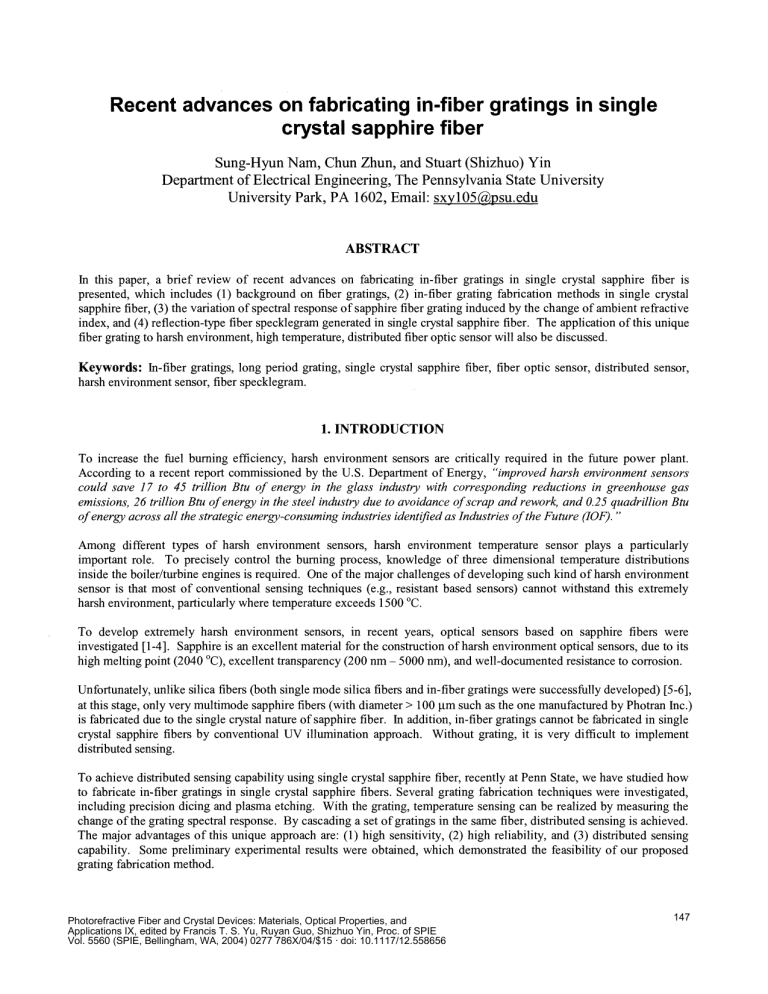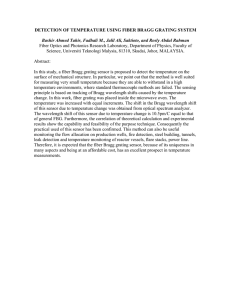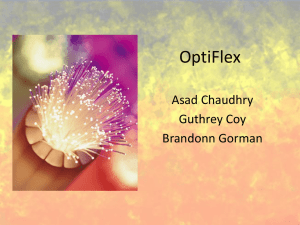SPIE Paper 5560-21
advertisement

Recent advances on fabricating in-fiber gratings in single
crystal sapphire fiber
Sung-Hyun Nam, Chun Zhun, and Stuart (Shizhuo) Yin
Department of Electrical Engineering, The Pennsylvania State University
University Park, PA 1602, Email: sxy105@psu.edu
ABSTRACT
In this paper, a brief review of recent advances on fabricating in-fiber gratings in single crystal sapphire fiber is
presented, which includes (1) background on fiber gratings, (2) in-fiber grating fabrication methods in single crystal
sapphire fiber, (3) the variation of spectral response of sapphire fiber grating induced by the change of ambient refractive
index, and (4) reflection-type fiber specklegram generated in single crystal sapphire fiber. The application ofthis unique
fiber grating to harsh environment, high temperature, distributed fiber optic sensor will also be discussed.
Keywords: In-fiber gratings, long period grating, single crystal sapphire fiber, fiber optic sensor, distributed sensor,
harsh environment sensor, fiber specklegram.
1. INTRODUCTION
To increase the fuel burning efficiency, harsh environment sensors are critically required in the future power plant.
According to a recent report commissioned by the U.S. Department of Energy, "improved harsh environment sensors
could save 1 7 to 45 trillion Btu of energy in the glass industry with corresponding reductions in greenhouse gas
emissions, 26 trillion Btu ofenergy in the steel industry due to avoidance ofscrap and rework, and 0.25 quadrillion Btu
ofenergy across all the strategic energy-consuming industries identifIed as Industries ofthe Future (IF)."
Among different types of harsh environment sensors, harsh environment temperature sensor plays a particularly
important role. To precisely control the burning process, knowledge of three dimensional temperature distributions
inside the boiler/turbine engines is required. One of the major challenges of developing such kind of harsh environment
sensor is that most of conventional sensing techniques (e.g., resistant based sensors) cannot withstand this extremely
harsh environment, particularly where temperature exceeds 1 500 °C.
To develop extremely harsh environment sensors, in recent years, optical sensors based on sapphire fibers were
investigated [1-4]. Sapphire is an excellent material for the constmction ofharsh environment optical sensors, due to its
high melting point (2040 °C), excellent transparency (200 nm — 5000 nm), and well-documented resistance to corrosion.
Unfortunately, unlike silica fibers (both single mode silica fibers and in-fiber gratings were successfWly developed) [5-6],
at this stage, only very multimode sapphire fibers (with diameter > 1 00 im such as the one manufactured by Photran Inc.)
is fabricated due to the single crystal nature ofsapphire fiber. In addition, in-fiber gratings cannot be fabricated in single
crystal sapphire fibers by conventional UV illumination approach. Without grating, it is very difficult to implement
distributed sensing.
To achieve distributed sensing capability using single crystal sapphire fiber, recently at Penn State, we have studied how
to fabricate in-fiber gratings in single crystal sapphire fibers. Several grating fabrication techniques were investigated,
including precision dicing and plasma etching. With the grating, temperature sensing can be realized by measuring the
change of the grating spectral response. By cascading a set of gratings in the same fiber, distributed sensing is achieved.
The major advantages of this unique approach are: (1) high sensitivity, (2) high reliability, and (3) distributed sensing
capability. Some preliminary experimental results were obtained, which demonstrated the feasibility of our proposed
grating fabrication method.
Photorefractive Fiber and Crystal Devices: Materials, Optical Properties, and
Applications IX, edited by Francis T. S. Yu, Ruyan Guo, Shizhuo Yin, Proc. of SPIE
Vol. 5560 (SPIE, Bellingham, WA, 2004) 0277 786X/04/$15 · doi: 10.1117/12.558656
147
2. BACKGROUND ON IN-FIBER GRATINGS
There are basically two types of in-fiber gratings. One type is fiber Bragg grating (FBG) that couples forward and
backward propagation modes [6], as shown in Fig. 1(a). The grating equation for Bragg grating is
24Ar
(1)
where n, A, and 2r are effective refractive index of fiber core, grating period, and resonant wavelength, respectively.
Based on Eq. (1), it can be seen that the grating period is smaller than wavelength, which is usually less than 1/urn.
Another type of grating is long period grating (LPG) that couples core and cladding modes [7, 8], as shown in Fig. 1 (b).
The grating equation for LPG is
2r
(neff cl
\co
eff).A
where 2r
(2)
n( , n(/ , and A are resonant wavelength, effective refractive indices of core and cladding, and grating
period, respectively. Since the refractive indices of core and cladding are very close (1 % difference in common), the
grating period, A, of LPG is usually much larger than the resonant wavelength, 2r' which can be in the order of
hundreds of microns. This is why this type of grating is usually called long period gratings.
Forward mode
Backward mode
Figure 1(a) An illustration of in-fiber Bragg grating
Fiber cad.ding
Figure 1 (b) An illustration of in-fiber long period grating.
Since long period grating can be more sensitive to environmental factors and easier for fabrication, our current effort at
Penn State is focused on long period ratings.
3. FABRICATING IN-FIBER GRATINGS IN SINGLE CRYSTAL SAPPHIRE FIBER.
3.1 Fabricating in-fiber long period gratings in single crystal sapphire fibers by precision dicing
The first method that we investigate is to fabricate LPG in single crystal sapphire fiber by precise dicing. In our
preliminary experiment, a 5 cm long single crystal sapphire fiber, with 1 50 micron diameter, was used. In order to hold
the fiber, the fiber sample was attached to a 2" x 2" glass substrate with Crystalbond 509 adhesive and the use of a hot
plate at 135 °C. The glass substrate was then placed on a computer-controlled chuck underneath a diamond saw blade.
By applying a minimum vacuum of 80 psi, the substrate was firmly held by the chuck once it was properly aligned. The
control box was then programmed to provide continuous cuts with a period of 1 50 micron and a depth of 50 micron.
Note that, the thickness of diamond blade is about 60 micron so that a 50% duty cycle grating can be obtained. Figure 2
shows the fabricated grating using dicing approach. It can be clearly seen that the quality of the grating is quite good.
148
Proc. of SPIE Vol. 5560
Figure 2 Fabricated in-fiber gratings in single crystal sapphire fibers by direct diamond blade dicing. Grating period
A=lSOpn.
The major advantages ofthis dicing approach are: (1) fabricated grating has a large depth; and (2) fabrication process is
simple and fast. However, it also suffers following limitations: (1) the minimum grating period is limited by the
thickness of diamond saw blade; and (2) it is difficult to fabricate complicated micro structures. Thus, only LPGs can
be fabricated by this direct dicing approach [7-8], which has a grating period in the order of hundreds of microns. It is
difficult to fabricate sub-micron short period Bragg gratings [6] by this simple dicing approach.
3.2 Fabricate in-fiber gratings in single crystal sapphire fibers by plasma etching
To fabricate shorter period grating in single crystal sapphire fibers, we also propose plasma etching approach. Recently,
micro structures have been successfully fabricated in sapphire substrate by plasma etching. It was reported that an
etching rate 65 nmlmin with selectivity to Ni mask > 7: 1 was realized by using Plasmalab 80 Plus etching machine [9].
In this approach, at the first step, the fiber can be coated by positive photoresist with required grating periods (hundreds
of microns for LPG and sub microns for FBG). The fiber is then placed in a sputtering system and a 150 nm Nickel
layer is deposited on the sapphire fiber surface. To ensure a good uniformity along the fiber surface, the fiber can be
slowly rotated along the fiber axis during the sputtering process. After that, the part of fiber with photoresist will be
removed by photoresist remover so that a positive Nickel grating mask can be deposited on the sapphire fiber surface.
Next, this fiber is put in the plasma etching machine so that the part without Nickel will be substantially etched. Finally,
the Nickel on the surface is removed by a proper acid; therefore, a periodic corrugated grating can be fabricated on the
fiber surface. Figure 3 illustrates this plasma etching process.
/
su a
resist
fiber .
'
/
s
I
1J
I
A-45Onrn
water
'
t\\k;
•1
tN \ \K\\ t
( \t
:
D—shipe fiber
Meta' mask
l 5Oiir
H
I\ \ (
\\
Mcro-strtctured hber
Figure 3. An illustration offabricating in-fiber grating in single crystal sapphire fiber by plasma etching.
Proc. of SPIE Vol. 5560
149
4. PRELIMINARY EXPERIMENTAL RESULTS
4.1 The variation of spectral response of sapphire fiber grating induced by the change of ambient refractive index
To confirm the grating effect for the gratings fabricated by precision dicing, an experimental setup, as shown in Fig. 4,
was built. The light source was a HP 81 68E tunable laser. As the output of the tunable laser was connectorized with
FCIPC, collimating optics was used to collimate the beam coming out of the connector end. NEW FOCUS model 9091
five-axis fiber aligner was used for this purpose. The collimated light beam was focused on the one end of the sapphire
fiber sample by a microscope object lens (x20). The output beam of the sapphire fiber was directly coupled to a regular
multimode fiber which was connected to HP 70951B optical spectrum analyzer (OSA). To get the optimum beam
coupling between the fibers, Newport 462 series precise 3 axis aligner was used. A sample chamber was made to contain
the index matching oil for the cladding of the sapphire fiber. The fiber sample penetrated this chamber and the index
matching oil was provided through top open cover.
For the micro-machined gratings (i.e., precision diced grating) to work as long period gratings (LPG), well defined
uniform cladding layer has to be formed. However, commercially available sapphire fibers do not have cladding layers.
To avoid this problem, one of the ways for watching the effect of micro-machined gratings is to observe radiation
coupling assisted by the gratings. A simple slab waveguide model can be used to explain this effect. If the periodic
perturbation is to couple the light from the guided mode to a wave propagating into the surrounding cladding and making
angle 0 with the direction ofpropagation as shown in Fig 5(a), then we must have the following relation as shown in Fig.
5(b).
f3—K=k0ncose
(3)
(propagation constant), K = 2.irl A (grating vector).
When this, so called, quasi-phase matching condition is satisfied, the radiation coupling from the guide mode to cladding
occurs. Fig 5(c) shows the calculated wavelength dependence of radiation angle according to the quasi-phase matching
condition. In the calculation, the effective refractive index of core is assumed to 1 .78. The region below O angle means
that no radiation coupling is allowed. As we can see from the graph, when the refractive index of the cladding is 1.765,
the radiation coupling occurs for the longer wavelength than 1550 nm. This model gives us good qualitative explanation
for the case of sapphire fiber. For a certain refractive index of cladding, the radiation coupling will occur for longer
wavelength than a specific value.
where /3 = 2s'rnejj. 1
Fig 4. The experimental setup for measuring radiation-mode coupl
gratings in the sapphire fiber
150
Proc. of SPIE Vol. 5560
t by micro-structured
While changing the refractive index matching oil (Cargille Laboratories, refractive index liquids M series) for the
cladding of the fiber in the chamber, output spectrums were observed. The measured spectrums are shown in Fig. 6.
With air cladding and I .79 index cladding, the spectrums didn't change much. When the refractive index was 1 .795, we
can see the grating-assisted radiation coupling took place in the longer wavelength region (>1540nm). With 1 .80 index
cladding, output light has almost disappeared. Note that the values of refractive index of the index matching oil are
dependent on the wavelength. The provided values by the manufacturer were measured at visible wavelength. The
measured coupling efficiency of the grating was a little bit low, which is believed due to the inaccuracy of dicing saw
(normally nanometer order accuracy is required) and surface roughness.
A
______
k
k—
—WI
______
13
Li—Lf--LrLrli---tl--Li--{i
K0ncosO
(b)
(a)
Radiation angle vs. Wavelength
n=1 .77
4.5
1.769
4
a
1.767
3
1 766
2
1.5
1.765
//
/
1460
1480
1500
1520
I
I
1540
1560
1580
Wavelenth (nm)
(c)
Fig. 5 Wavelength dependence of radiation mode coupling
Proc. of SPIE Vol. 5560
151
(b) 1.79
(c) 1.795
(d) 1.80
Fig. 6 The output spectrum ofthe sapphire fiber with surface gratings
for different cladding refractive indices.
4.2 Reflection-type fiber specklegrani generated in single crystal sapphire fiber
To frirther verify the grating effect, an experimental setup used to observe the reflected light from grating area was built.
Again, due to the multimode nature of sapphire fiber, the detected reflected light becomes a reflection-type fiber
specklegram. Figures 7(a) and 7(b) shows the configuration of experimental setup and corresponding picture of the
setup, respectively.
152
Proc. of SPIE Vol. 5560
0
Beam SpUtter
U
Dm) ndc m tchng o
.
t'
HN
iber
CCD Camera
rntching
Figure 7(a) Experimental setup used to verify the reflection from the diced grating.
Figure 7(b) A picture of experimental setup used to verify the reflection from the diced grating.
The light beam from a He-Ne laser is coupled into the sapphire fiber by a microscope objective. To avoid the reflection
from front and back surfaces, the front surface is angle polished and the back surface is immersed in the index matching
oil. The reflected light from diced grating is detected by the CCD camera.
Figure 8(a) shows the detected back reflected speckle pattern without adding index-matching oil in the diced area. It can
be seen that the reflected speckle field is strong. Figure 8(b) shows the detected back reflected speckle field with adding
index-matching oil in the diced area. It can be clearly seen that the detected speckle field is much weak. Thus, indeed,
there is grating induced reflections.
Proc. of SPIE Vol. 5560
153
Figure 8(a). The detected back reflected speckle pattern without adding index-match oil.
Figure 8(b). The detected back reflected speckle pattern with adding index-match oil.
5. CONCLUSIONS
In conclusion, a brief review on recent advances on fabricating in-fiber gratings in single crystal sapphire fibers was
presented. Two types of grating fabrication methods, including directly precision dicing and plasma etching were
discussed. The direct dicing approach is more suitable for LPGs while plasma etching method may be used for both the
LPG and Bragg gratings. Our preliminary experiments demonstrated that LPG indeed could be fabricated by directly
precision dicing. Furthermore, the grating effects from this diced grating were experimentally observed by the change
in radiation modes and reflected specklegram pattern. This unique in-fiber grating in single crystal sapphire fiber could
result in a new generation of high temperature harsh environment distributed sensor [10-12]. The deployment of this
novel sensor may substantially increase the burning efficiency and reduce pollutant emissions.
Acknowledgement
Authors greatly appreciate partial financial support of this work by DoE.
154
Proc. of SPIE Vol. 5560
REFERENCES
1) G. N. Merberg and J.A. Barrington, "Optical and mechanical properties of single-crystal sapphire optical
fibers," Appl. Opt. 32, 18, 3201 (1993).
2) Y. Shen, L. Tong, and S. Chen, "Performance stability of the sapphire fiber and cladding under high
temperature," Proc. SPIE 3852, 134 (1999).
3) S. C. Bates and R. F. Chang, "High temperature fiber optic imaging," Fiber and Integrated Optics 6, 387 (1997).
4) 5. C. Bates, "High temperature sapphire fiber cladding," STTR final report, March, AFOSR Contract# F4962098-C-0063 (1999).
5) H. Murata, Handbook ofopticalfIbers and cables, Marcel Dekker, Inc. New York p. 135 (1996).
6) A. Othonos and K. Kalli, Fiber Bragg gratings, Artech House, Boston, Chapter 3, p. 95 (1999).
7) Turan Erdogan, "Cladding-mode resonances in short- and long- period fiber grating filters," J. Opt. Soc. Am. A,
14,pp. 1760-1773 (1997).
8) S. Yin, K. Chung, and X. Zhu, "Highly sensitive long period grating based tunable filter using a unique doublecladding layer structure," Optics Communications, v 188, pp. 301-305 (2001).
9) www.oxfordplasma.de/process/sapphire .htm
10) C. M. Lawrence, D. V. Nelson and E. Udd, "Multiparameter sensing with fiber Bragg Gratings," SPIE 2872, pp.
24-31 (1996).
11) C. M. Lawrence, D. V. Nelson, E. Udd, and T. Bennett, "A fiber-optic sensor for transverse strain
measurement," Experi. Mech., vol. 38, 202-209 (1999).
12) M. Song, S. Yin, P. Ruffin, "Fiber Bragg grating strain sensor demodulation with quadrature sampling of a
Mach-Zehnder interferometer4," Applied Optics, v39, pp. 1106-1111, March (2000).
Proc. of SPIE Vol. 5560
155


